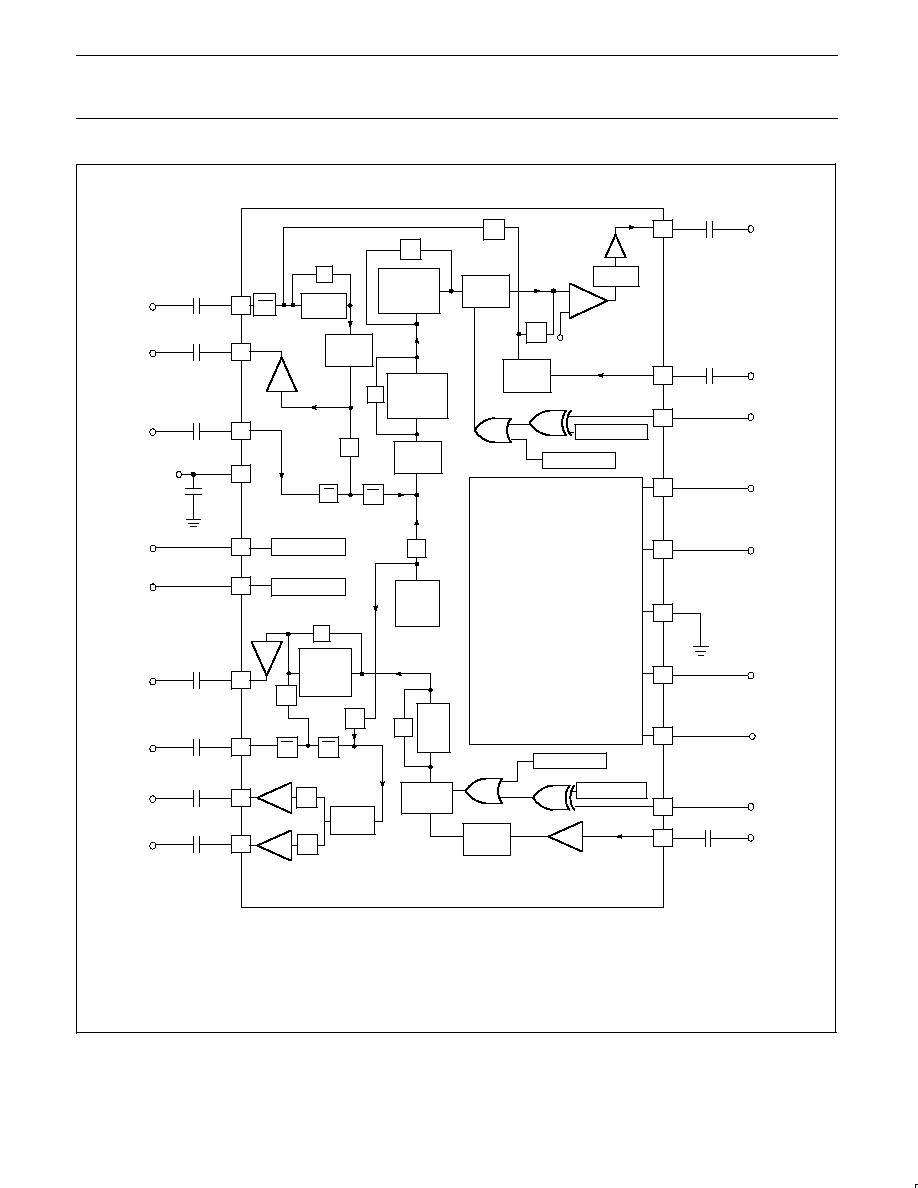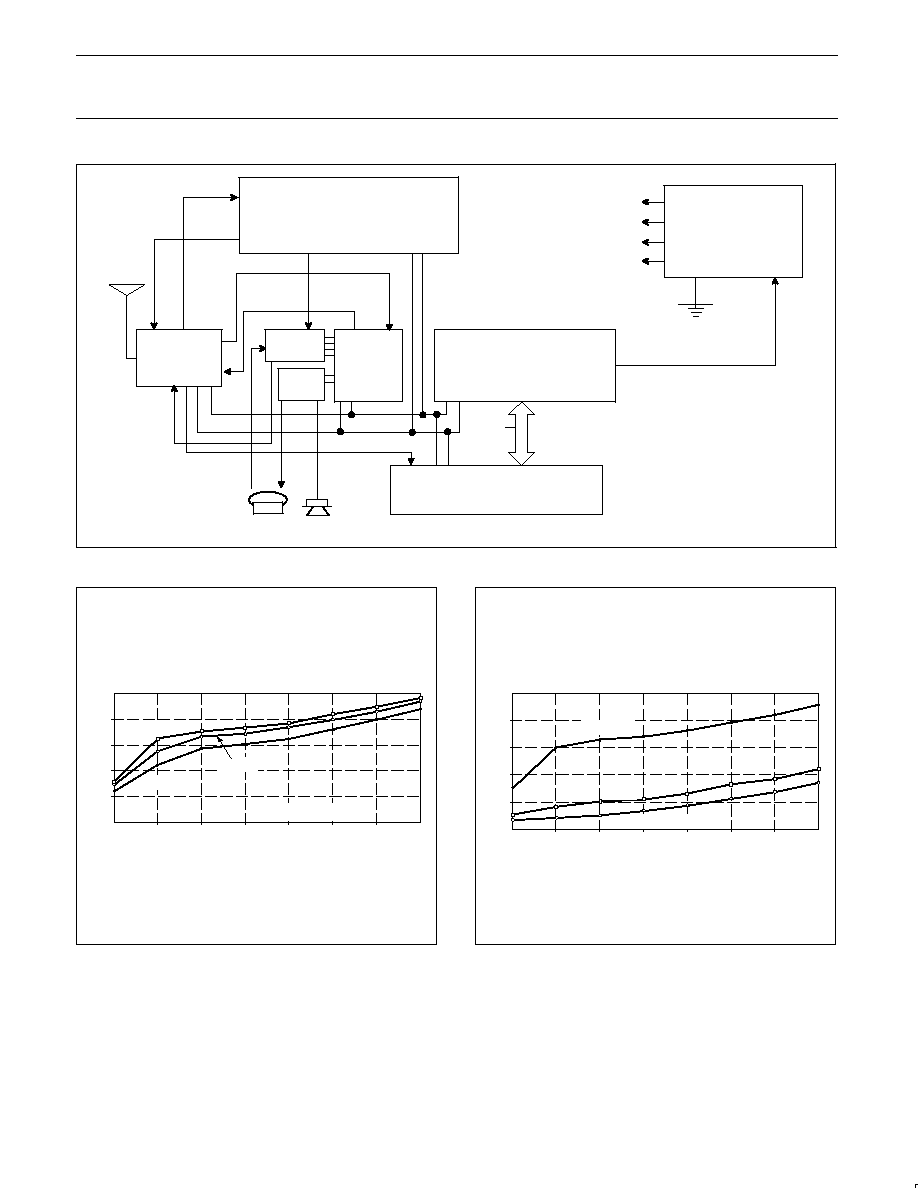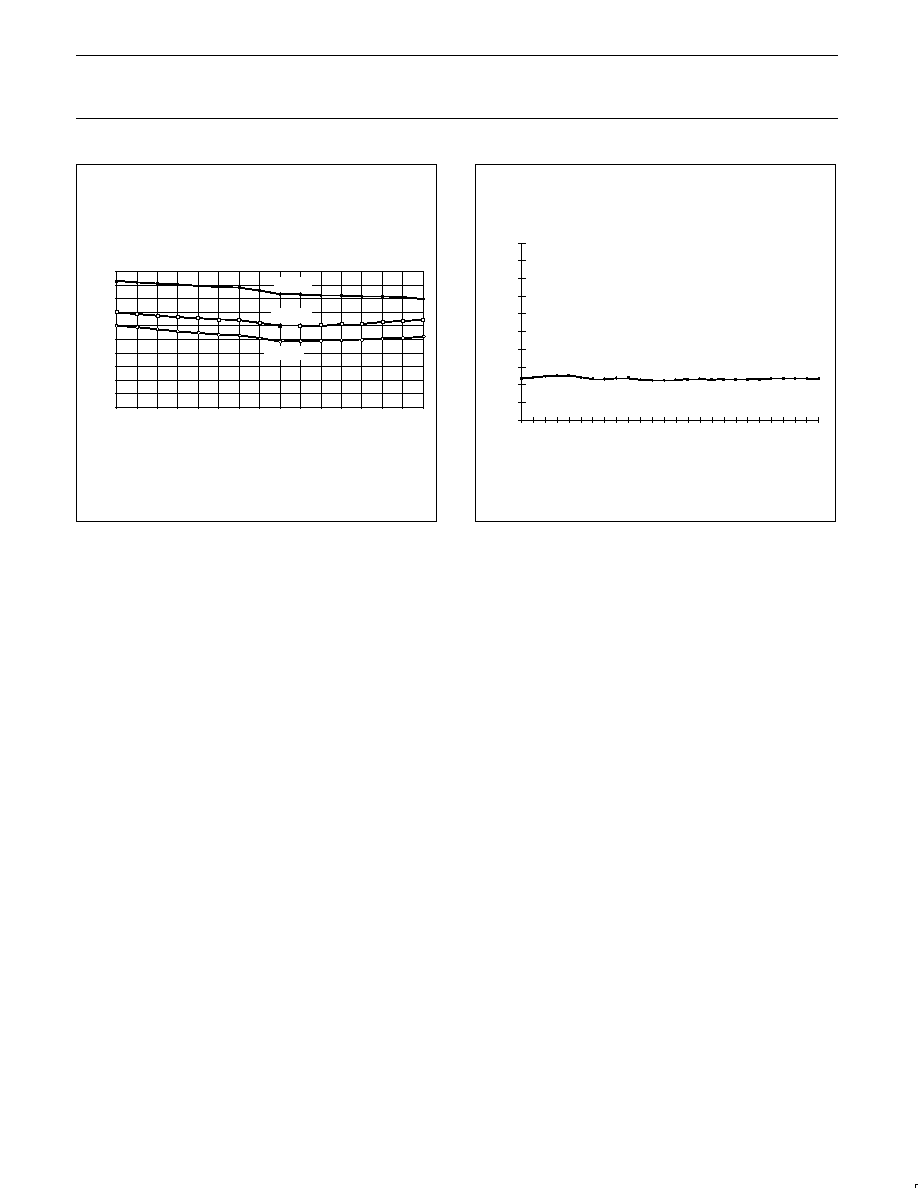 | –≠–ª–µ–∫—Ç—Ä–æ–Ω–Ω—ã–π –∫–æ–º–ø–æ–Ω–µ–Ω—Ç: SA5753ADK | –°–∫–∞—á–∞—Ç—å:  PDF PDF  ZIP ZIP |
Document Outline
- DESCRIPTION
- BENEFITS
- APPLICATIONS
- PIN CONFIGURATION
- FEATURES
- ORDERING INFORMATION
- ABSOLUTE MAXIMUM RATINGS
- PIN DESCRIPTIONS
- DC ELECTRICAL CHARACTERISTICS
- AC ELECTRICAL CHARACTERISTICS
- FUNCTIONAL DESCRIPTION
- Gain Blocks
- NAMPS and VCO Offsets
- Operation Using the I 2 C Communications Bus
- Power On Reset and Power Down Modes
- Operation Without Using the I 2 C Bus
- Programming Without the I 2 C Protocol
- Cordless Telephone Applications
- I 2 C CHARACTERISTICS
- Data Transfer
- Start and Stop Conditions
- Acknowledgement
- I 2 C Bus Data Configurations
- Control Registers
- High Tone DTMF Register
- Low Tone DTMF Register
- PACKAGE OUTLINE
- DEFINITIONS

Philips
Semiconductors
SA5753
Audio processor -- filter and control
section
Product specification
Replaces data of 1995 July 7
1997 Nov 07
INTEGRATED CIRCUITS
IC17 Data Handbook

Philips Semiconductors
Product specification
SA5753
Audio processor ≠ filter and control section
2
1997 Nov 07
853-1722 18666
DESCRIPTION
The SA5753 is a high performance low power CMOS audio signal
processing system especially designed to meet the requirements for
small size and low voltage operation of hand-held equipment. The
SA5753 subsystem includes complementary transmit/receive voice
band (300-3000Hz), switched capacitor bandpass filters with
pre-emphasis and de-emphasis respectively, a transmit low pass
filter, peak deviation limiter for transmit, digitally controlled
attenuators for signal level and volume control, audio path mute
switches, a programmable DTMF generator, power-down circuitry
for low current standby, power-on reset capability, and an I
2
C
interface. When the SA5753 is used with an SA5752 (companding
function), the complete audio processing system of an AMPS,
TACS, NAMPS or NTACS cellular telephone is easily implemented.
The system also meets the requirements of the proposed NAMPS or
NTACS specification, and can be used in cordless telephone
applications.
The SA5753 can be operated without the I
2
C bus interface by
pulling DFT (Pin 13) HIGH.
BENEFITS
∑
Very compact application
∑
Long battery life in portable equipment
∑
Complete cellular audio function with the SA5752
APPLICATIONS
∑
Cellular radio
∑
Mobile communications
∑
High performance cordless telephones
∑
2-way radio
PIN CONFIGURATION
TXBFIN
PREMPIN
VOXCTL
HPDN
DEMPOUT
AUDIOIN
DFT
CLKIN
GND
TX MUTE
TXOUT
DK Package
1
2
3
4
5
6
7
8
9
10
11
12
13
14
20
19
18
17
16
15
TXBFOUT
VDD
SPKROUT
EAROUT
DATAIN
SDA
SCL
RX MUTE
SA5753
RX DEMODIN
SR00666
Figure 1. Pin Configuration
FEATURES
∑
Low 3V supply
∑
Miniature SSOP package
∑
Low power
∑
High performance
∑
Built-in programmable DTMF generator
∑
Built-in digitally controlled attenuators for modulation and volume
control
∑
Built-in peak-deviation limiter
∑
I
2
C Bus controlled
∑
Power-on reset
∑
Power down capability
∑
Programmable mute control
∑
Meets AMPS/TACS/NAMPS/NTACS requirements
ORDERING INFORMATION
DESCRIPTION
TEMPERATURE RANGE
ORDER CODE
DWG #
20-Pin Plastic Shrink Small Outline Package (SSOP)
-40 to +85
∞
C
SA5753DK
SOT266-1
ABSOLUTE MAXIMUM RATINGS
SYMBOL
PARAMETER
RATING
UNIT
V
DD
Power supply voltage range
-0.3 to 6
V
V
IN
Voltage applied to any other pin
-0.3 to V
DD
+0.3
V
Storage temperature
-65 to +150
o
C
T
A
Ambient operating temperature
-40 to +85
∞
C

Philips Semiconductors
Product specification
SA5753
Audio processor ≠ filter and control section
1997 Nov 07
3
PIN DESCRIPTIONS
PIN NO.
SYMBOL
DESCRIPTION
1
TXBF
IN
Transmit bandpass filter input
2
TXBF
OUT
Transmit bandpass filter output
3
PREMP
IN
Pre-emphasis input
4
V
DD
Positive supply
5
VOX
CTL
Vox control output
6
HPDN
Power-down I/O
7
DEMP
OUT
De-emphasis output
8
AUDIO
IN
Audio input
9
SPKR
OUT
Audio output to speaker
10
EAR
OUT
Audio output to earpiece
11
RX DEMOD
IN
Rx demodulated audio signal input
12
RX MUTE
RX audio signal mute input
13
DFT
Default input, non-I
2
C or stand-alone operation
14
CLK
IN
Clock input (1.2MHz)
15
GND
Ground
16
SCL
I
2
C serial clock line
17
SDA
I
2
C serial data line
18
TX MUTE
Tx audio signal mute input
19
DATA
IN
Data input
20
TX
OUT
Transmit output

Philips Semiconductors
Product specification
SA5753
Audio processor ≠ filter and control section
1997 Nov 07
4
DC ELECTRICAL CHARACTERISTICS
T
A
= 25
o
C, V
DD
= +3.3V, unless otherwise specified. See test circuit, Figure 2.
SYMBOL
PARAMETER
TEST CONDITIONS
LIMITS
UNIT
SYMBOL
PARAMETER
TEST CONDITIONS
MIN
TYP
MAX
UNIT
V
DD
Power supply voltage
3.0
3.3
5.5
V
I
DD
Supply current
Operating
IDLE
Power Down (PWDN)
1.7
600
200
mA
µ
A
µ
A
I
IH
Input current high
TX MUTE, RX MUTE, HPDN
DFT
V
IN
= V
DD
≠10
0
0
+10
+10
+30
µ
A
µ
A
I
IL
Input current low
TX MUTE, RX MUTE,
HPDN, DFT
V
IN
= GND
≠30
≠10
≠10
0
0
+10
µ
A
µ
A
V
IH
Input voltage high
0.7V
DD
V
DD
V
V
IL
Input voltage low
0
0.3V
DD
V
AC ELECTRICAL CHARACTERISTICS
T
A
= 25
o
C, V
DD
= +3.3V. See test circuit, Figure 2. Clock frequency = 1.2MHz; test level = 0dBV = 77.5mV
RMS
= -20dBm, unless otherwise
specified. All gain control blocks (Attenuators) = 0dB gain, NAMPS and VCO bits set to 0.
SYMBOL
PARAMETER
TEST CONDITIONS
LIMITS
UNIT
SYMBOL
PARAMETER
TEST CONDITIONS
MIN
TYP
MAX
UNIT
RX BPF anti alias rejection
40
dB
RX BPF input impedance
f= 1kHz
100
k
RX BPF gain with de-emphasis
f = 1kHz
-1.0
0
1.0
dB
RX BPF gain with de-emphasis
f = 100Hz
-30
dBm0
RX BPF gain with de-emphasis
f = 300Hz
8.5
9.6
11.5
dBm0
RX BPF gain with de-emphasis
f = 3kHz
-11.5
-10.0
-8.5
dBm0
RX BPF gain with de-emphasis
f = 5.9kHz
-58
dBm0
RX BPF noise with de-emphasis
300Hz-3kHz
200
µ
V
RMS
RX dynamic range
with deemphasis
80
dB
DEMP
OUT
output impedance
f = 1kHz
40
DEMP
OUT
output swing (1%)
2k
to V
DD/2
; f = 1kHz
2.4
V
P-P
SPKR
OUT
ouput swing (1%)
50k
toV
DD/2
; f = 1kHz
V
DD
-1
2.4
V
P-P
EAR
OUT
output swing (1%)
50k
to V
DD/2;
f = 1kHz
V
DD
-1
2.4
V
P-P
SPKR
OUT
noise / EAR
OUT
noise
200
µ
V
RMS
CLK
IN
high
2.1
3.0
V
CLK
IN
low
0
1.0
V
TX BPF anti alias rejection
f > 50kHz
40
dB
TX BPF input impedance
f = 3kHz
100
K
TX BPF noise
300 - 3000kHz
200
µ
V
RMS
TX LPF gain
f = 5.9kHz
-39
-36
dBm0
TX LPF gain with pre-emphasis
f = 1kHz, 0dBV
2.43
dB
TX LPF gain with pre-emphasis
f = 100Hz
-19
dBm0
TX LPF gain with pre-emphasis
f = 300Hz
-10.45
dBm0
TX LPF gain with pre-emphasis
f = 3kHz
9.14
dBm0
TX LPF gain with pre-emphasis
f = 5900Hz
-28
dBm0
TX LPF gain with pre-emphasis
f = 9kHz
-48
dBm0
TX overall gain
1kHz
2.43
dB
TX overall gain
100Hz
-58
-44
dBm0
TX overall gain
300Hz
-11.5
-10.4
-8.5
dBm0

Philips Semiconductors
Product specification
SA5753
Audio processor ≠ filter and control section
1997 Nov 07
5
AC ELECTRICAL CHARACTERISTICS (continued)
SYMBOL
PARAMETER
TEST CONDITIONS
LIMITS
UNIT
SYMBOL
PARAMETER
TEST CONDITIONS
MIN
TYP
MAX
UNIT
TX overall gain
3kHz
8
9
9.6
dBm0
TX overall gain
5.9kHz
-52
-45
dBm0
TX BPF dynamic range
TBD
dB
PREMP
IN
input impedance
f = 3kHz
100
k
TX
OUT
Slew rate
C
L
= 15pF
0.75
V/
µ
s
Output impedance
f = 3kHz
40
Output swing (limiting)
1.2
V
P-P
Output swing (1% THD)
5k
load (25
∞
C)
1.0
V
P-P
Tx DTMF signal with TXLPF and pre-emphasis
0.45
V/kHz
Rx DTMF sidetone
≠0.8
5.2
dBm0
Time delay to mute from RX MUTE or TX MUTE
transition
V
IN
= V
IL
to V
IH
V
IN
= V
IH
to V
IL
0.5
0.5
µ
s
µ
s
Table 1. Gain Control Blocks (Bit 0 is Least Significant Bit)
SYMBOL
Bits
TYPICAL STEP (dB)
TYPICAL GAIN (dB)
SYMBOL
Bits
TYPICAL STEP (dB)
MIN
MAX
A1
4
≠0.8
≠12.0
0
A2a
5
±
0.25
≠3.75
+3.75
A2b
2
≠6, (≠12 on first)
≠24.0
0
A3
4
≠1.0
≠17.0
≠2.0
A4
4
±
0.5
≠3.5
+3.5
A6
4
≠2.0
≠30.0
0
A7
4
±
0.5
≠3.5
+3.5
NAMPS
1
+1.9 in A2b
≠7.6 in A4
VCO
1
+6.0 in A4
For A2a, A4 and A7:
MSB sets the sign of the gain
MSB = 0 for gain
MSB = 1 for attenuation
For all Gain Blocks:
All bits set to 0 = 0dB gain
All bits set to 1 = maximum gain or attenuation
FUNCTIONAL DESCRIPTION
The SA5753 is an audio signal processor designed to meet the
requirements of compact low voltage radio telephone equipment. It
includes transmit and receive bandpass filters for voiceband
(300-3000Hz) with pre-emphasis and de-emphasis respectively, a
transmit peak deviation limiter, voice channel mute switches and a
data path which can be summed into the transmit channel. An I
2
C
interface is provided for software programmability of a DTMF
generator, mute polarity, selection of different power down and
operating modes and control of the gain in both the transmit and
receive channels.
Software programmable gain control allows the device to be
automatically optimized during equipment production and offers
flexibility during normal operation.
Gain Blocks
The programmable gain blocks are shown in Table 1 and Figure 2.
The purpose for each block is as follows:
a. A1 compensates for microphone gain variations in the transmit
path.
b. A2a compensates for transmitter dynamic range variations due to
manufacturing tolerances of the SA5753 and SA5752 compandor
companion device. To meet AMPS requirements, the dynamic
range between the zero crossing signal level of the compandor
and the peak signal allowed by the deviation limiter is adjusted to
12.34dB.
c. A2b allows coarse attenuation to be inserted in the transmit path
to eliminate positive feedback effects in hands-free speaker
applications. First step is 12dB followed by two steps of 6dB.
d. A3 sets the gain between the DATA
IN
pin (Pin 19) and the TX
OUT
pin (Pin 20) and should be adjusted after A2a and A4 have been
previously optimized. The SA5753 will interface directly with the
UMA1000T data processor (which produces a 2Vpk data signal).
For NAMPS applications an additional 10 to 14dB resistive divider
must be added at the DATA
IN
pin (Pin 19) for a 2V data signal.

Philips Semiconductors
Product specification
SA5753
Audio processor ≠ filter and control section
1997 Nov 07
6
e. A4 compensates for transmit gain variations due to manufacturing
tolerances of the SA5753, SA5752 and VCO connected to TX
OUT
(Pin 20). After A2a has been adjusted to set dynamic range then
A4 is used to set the peak output voltage at TX
OUT
(Pin 20) such
that a nominal 10kHz/V VCO produces a peak deviation of 12kHz
to meet AMPS specifications.
f. A6 is the volume control for both the SPKR
OUT
and EAR
OUT
.
g. A7 compensates for manufacturing tolerances in the SA5753 and
preceeding demodulator. For AMPS requirements, a 1kHz tone
with 2.9kHz deviation should produce an output signal at
DEMP
OUT
(Pin 7) corresponding to the zero crossing signal level
of the expandor.
NAMPS and VCO Offsets
For NAMPS applications, a `1' programmed into R5B3 (register 5, bit
3) will offset the transmit gain for NAMPS applications. It is
recommended that A2a and A4 be programmed after the NAMPS
option is set to compensate for manufacturing tolerances in the
NAMPS offset, itself.
When the VCO bit of R5B2 is a `1', an extra gain of 6dB is provided
at TX
OUT
for direct interface to VCOs with a nominal gain of 5kHz/V.
Operation Using the I
2
C Communications Bus
The SA5753 includes on-chip gain blocks and options which can be
programmed through an I
2
C interface bus. To use this capability,
the DFT pin (Pin 13) must be pulled LOW. In this mode, all signal
level adjustments can be made through software with no external
potentiometers required.
With DFT pulled LOW, the HPDN pin (Pin 6) is an OUTPUT having
the same value as the program bit in register 5 bit 1 (R5B1) of the
control register bit map. The value at the VOX
CTL
output (Pin 5) is
the same as the program bit in R8B7. The HPDN and VOX
CTL
outputs can be used to control the state of the SA5752 companion
device.
Power On Reset and Power Down Modes
In order to avoid undefined states of the SA5753 when power is
initially applied, a power-on-reset circuit is incorporated which
defaults RxP and TxP such that the receive and transmit paths are
muted if a `high' voltage is applied to RX MUTE and TX MUTE (Pins
12 and 18). RX MUTE and TX MUTE include on-chip pull up
resistors so, during power up, the user may apply a logic `1' to these
pins or leave them floating. After power up, the registers can be
programmed and the mutes removed by a quick access write to R0.
Three software controlled low power modes are provided on the
SA5753. These are POWER DOWN (PWDN), IDLE and DENA and
can be selected by programming a `1' into R6B2, R6B1 or R6B0 as
follows. In PWDN mode (R6B2=1) both the voice and data
channels are powered down with the respective I/O pins at a high
impedance. In DENA mode (R6B1=1) the voice channels are
powered down, but the data channel (from DATA
IN
and TX
OUT
) is
fully active. In IDLE mode (R6B1=1, R6B0=1) both voice and data
channels are powered down. (See Table on page 8.)
The difference between selecting IDLE and PWDN is that the former
maintains the normal operational bias voltages at all voice and data
I/O pins and provides a glitch-free transfer from power down to a
fully active mode and vice-versa.
Although the POWER DOWN mode exhibits lower power
consumption, glitches may occur when transferring to an active
mode because of the previous high impedance of the I/O pins.
The VOX
CTL
and HPDN pins (Pins 5 and 6) still have the same
value as R8B7 and R5B1 in all low power modes.
Operation Without Using the I
2
C Bus
The SA5753 can be operated in a default mode with the I
2
C bus
bypassed. To use this mode, the DFT pin (Pin 13) is pulled HIGH,
then the I
2
C bus is bypassed and the SA5753 operates as if all
register bits in the I
2
C address map table are set to `0' except R1B2
(S13), R0B0 (S10) and R0B1 (S9), which are set to `1' to enable the
receiver output. R6B2 (PWDN), which is controlled by the state of
the HPDN pin (Pin 6), which is an input in DEFAULT mode.
When HPDN is pulled HIGH, the R6B2 bit is set to `0' and the
SA5753 is placed in it's normal operating mode with all Gain Control
Blocks set to 0dB except A3, which is set to ≠2dB.
When HPDN is pulled LOW, the R6B2 bit is set to `1' and the
SA5753 enters POWER DOWN.
There is no on-chip pull-up or pull-down structure on the HPDN pin
and so it must not be allowed to float in DEFAULT mode since the
operating mode of the SA5753 will then be undetermined.
The Tx MUTE and Rx MUTE pins must be pulled LOW to enable the
transmit and receive paths, respectively.
The VOXCTL pin (Pin 5) will follow the value of the control bit stored
in R8B7 prior to pulling DFT HIGH.
The DTMF is disabled in the DEFAULT mode.
Programming Without the I
2
C Protocol
In the default mode, with DFT (Pin 13) and HPDN (Pin 6) pulled
HIGH, the registers in the control register bit map are chained
together so that bit 0 of a register is connected to bit 7 of the
preceeding register with R0B6, R0B7, R1B6 and R1B7 bypassed,
i.e., R0B5 is connected to R1B0, R1B5 is connected to R2B0, R2B7
is connected to R3B0, etc. Bits can then be loaded as a serial
stream through the SDA pin of the I
2
C bus by the negative edge of a
shifting clock applied at the SCL pin of the I
2
C bus. When a bit is
loaded at SDA it will load first into R0B0 and then will be shifted to
R8B7 after 68 clock edges.
A total of 68 clock pulses (applied at SCL) are therefore required to
completely load the registers.
In this mode of operation the contents of the register map are also
shifted out from the VOX
CTL
pin since it takes the same value as
R8B7. After power up there is no reset within the registers so the
first 68 bits clock out at the VOX
CTL
pin will have an indeterminate
value.
Summary: To use this capability, the DFT pin and the HPDN pin
must be pulled HIGH, the serial bit stream loaded through SCL
synchronous with the negative clock edge applied at SCL for 68
clock pulses, and then the DFT pin pulled LOW.
NOTE: Default Mode is not tested in production.

Philips Semiconductors
Product specification
SA5753
Audio processor ≠ filter and control section
1997 Nov 07
7
Cordless Telephone Applications
For cordless telephone applications, a switch S12 is provided
(R5B0) to route data through the complete transmit path while
inhibiting the voice channel. In the receive path, a quick access
mode is provided through the I
2
C to disable both EAR
OUT
and
SPKR
OUT
, by setting R0B0 and R0B1, when data is detected at the
DEMP
OUT
pin (Pin 7).
I
2
C CHARACTERISTICS
The I
2
C bus is for 2-way, 2-line communication between different
ICs or modules. The two lines are a serial data line (SDA) and a
serial clock line (SCL). Both SDA and SCL are bidirectional lines
connected to a positive supply voltage via a pull-up resistor. When
the bus is free, both lines are HIGH. Data transfer may be initiated
only when the bus is not busy (both lines HIGH).
The output devices, or stages, connected to the bus must have an
open drain or open collector output in order to perform the
wired-AND function.
Data at the I
2
C bus can be transferred at a rate up to 100kbits/s.
The number of devices connected to the bus is solely dependent on
the maximum allowed bus capacitance of 400pF.
For devices operating over a wide range of supply voltages, such as
the SA5753, the following levels have been defined for a logical
LOW and HIGH;
V
ILMAX
= 0.3V
DD
(max. input LOW voltage)
V
IHMIN
= 0.7V
DD
(min. input HIGH voltage)
Data Transfer
Data is transferred from a transmitting device to a receiving device
with one data bit transferred during each clock pulse on the SCL
line. The transmitter also generates the clock once arbitration has
given it control of the SCL line. The data on the SDA line must
remain stable during the HIGH period of the clock cycle, otherwise it
may be interpreted as a control signal.
Start and Stop Conditions
Both data and clock lines remain HIGH when the bus is not busy. A
HIGH to LOW transition of the data line while the clock line is HIGH
is defined as a start condition. A LOW to HIGH transition of the data
line while the clock is HIGH is defined as a stop condition.
Acknowledgement
Following each byte of data transfered, the receiver must
acknowledge successful reception. To do this the transmitter
releases the SDA line (allowing it to go HIGH) at the end of each
transmitted byte, and it is pulled LOW by the receiver. If this
condition is maintained during the next HIGH period of the clock
pulse (called the acknowledge clock pulse) then data transfer is
resumed. If the receiver does not pull the SDA line LOW, the
transmitter will abort the transfer.
I
2
C Bus Data Configurations
The SA5753 is always a slave receiver in the I
2
C bus configuration).
The slave address consists of eight bits in the serial mode and is
internally fixed.
Control Registers
The control register bit map is shown below. Either a quick access
or normal address mode can be used, determined by the two MSB
bits in the first word following the SA5753 address word. If the quick
access mode is used, the registers R0 or R1 can be updated by
sending only two bytes of information (address plus update). If R0
or R1 are updated using the address mode, then B7 and B6 of the
data word are ignored. In all access modes, incremental register
addressing is supported with following words updating the next
register until a `stop' bit is sent.
High Tone DTMF Register
MSB
LSB
HD7 HD6 HD5 HD4 HD3 HD2 HD1 HD0
The eight bits determine the output frequency by the following
formula.:
High Frequency = 1200kHz/6/HD
where HD is the value of the register.
Low Tone DTMF Register
MSB
LSB
LD7 LD6 LD5 LD4 LD3 LD2 LD1 LD0
The eight bits determine the output frequency by the following
formula.:
Low Frequency = 1200kHz/14/LD
where LD is the value of the register.
The operation of the 96ms DTMF timer is initiated by the loading of
the low tone DTMF register. This timer terminates transmission of
the tones as the generated tones cross the reference level after
96ms. The on time of the tones can thus vary by up to one cycle of
the tones.
Continuous tones can be obtained by again loading DTC = 1 in R1,
bit 5.
Single tones can be obtained by loading 2 into the unused tone
register to silence it.
Loading a value of 1 or 0 into the registers will default the register
value to 257 or 256 for high tone or low tone, respectively.
Phase continuous frequency modulation can be produced by loading
a new value into a DTMF register during continuous operation
(DTC=1).

Philips Semiconductors
Product specification
SA5753
Audio processor ≠ filter and control section
1997 Nov 07
8
Mode
F7
F6
quick access
0
quick access
test mode
address mode
0
1
1
Load F5≠F0 to R0B5 ≠ R0B0
Load F5-F0 to R1B5 ≠ R1B0
F3≠F0 point to register
For test only. DO NOT USE.
Action
0
1
0
1
S
A7 A6 A5 A4 A3 A2 A1 A0
ACK
ACK
S = start, A0 = 0, ACK = acknowledge, P = stop, A7≠0 = SA5753 address fixed internally at 1000000.
I
2
C Address and Access
A1b3≠0
=
program bits for gain block A1
REG
F3
F2
R0
0
0
R1
R2
R3
R4
R5
R6
R7
0
0
0
0
0
0
0
0
0
0
1
1
1
1
F7 F6 F5 F4 F3 F2 F1 F0
...
P
Access mode is determined by F7, F6.
All access modes support incremental addressing.
F1
F0
0
0
0
1
1
0
0
1
1
1
0
1
0
1
0
1
R8
1
0
0
0
Address
HD7
LD7
A1b3
A6b3
A2ab4
A3b3
VOX
CTL
HD6
LD6
A1b2
A6b2
A2ab3
A3b2
S3
RxM
DTC
HD5
LD5
A1b1
A6b1
A2ab2
A3b1
S5
TxM
S4
HD4
LD4
A1b0
A6b0
A2ab1
A3b0
S6
A2bb1
S8
HD3
LD3
A4b3
NAMPS
A2ab0
A7b3
S11
A2bb0
S13
HD2
LD2
A4b2
VCO
PWDN
A7b2
RxP
S9
S7
HD1
LD1
A4b1
HPDN
IDLE 1
A7b1
TxP
S10
S2
HD0
LD0
A4b0
S12
IDLE 0
A7b0
S1
Address Map
For all bits TRUE = `1'
A2ab4≠0 =
program bits for gain block A2a
A2bb1≠0 =
program bits for gain block A2b
A3b3≠0
=
program bits for gain block A3
A4b4≠0
=
program bits for gain block A4
A5b2≠0
=
program bits for gain block A5
A6b3≠0
=
program bits for gain block A6
A7b3≠0
=
program bits for gain block A7
HD7≠0
=
high tone DTMF
LD7≠0
=
low tone DTMF
NAMPS
=
program bit for NAMPS offset
VCO
=
6dB higher TX
OUT
RxM
=
receive mute
TxM
=
transmit mute
RxP
=
receive mute polarity
TxP
=
transmit mute polarity
DTC
=
DTMF continuous
VOX
CTL
=
enable VOX of compandor/expander circuit. This bit appears at the VOX
CTL
pin (Pin 5) of the SA5753.
HPDN
=
enable power down of compandor circuit. This bit appears at the HPDN pin (Pin 6) of the SA5753
S4
=
enable DTMF to TX path and inhibit PREMP
IN
and S2.
S1
=
bypass TXBPF
S2
=
bypass compressor in TX path, inhibit pre-emph input
S12 =
cordless data option established
S5
=
bypass RXBPF
S6
=
bypass de-emph in RX path
S7
=
bypass expandor in RX path, inhibit audio input
S8
=
enable DTMF to RX path and inhibit AUDIO
IN
and S7.
S9
=
enable SPKR
OUT
S10 =
enable EAR
OUT
S11 =
bypass TXLPF
S13 =
enable data path
Register Bits
B7
B6
B5
B4
B3
B2
B1
B0
S3
=
bypass pre-emp and limiter in Tx path
PWDN
1
0
0
0
0
IDLE1
X
1
1
0
0
IDLE0
X
0
1
0
1
(PWDN) Complete power down except I
2
C, I/Os high impedance.
(DENA) Low power, I/Os at V
DD
/2, DATA
IN
to TX
OUT
enabled.
(IDLE) Low power, I/Os at V
DD
/2, DATA
IN
to TX
OUT
disabled.
Normal operation.
DATA
IN
to TX
OUT
disabled.
X = don't care.
Low Power Modes (R6B0 ≠ R6B2)
PWDN, IDLE1, IDLE0 see Table below
Y
Y
Y
Y
Y = ignored in address mode.
SR00667

Philips Semiconductors
Product specification
SA5753
Audio processor ≠ filter and control section
1997 Nov 07
9
AUDIOIN
VOXCTL
PREMPIN
TXBFOUT
TXBFIN
3
1
2
5
6
7
8
9
10
4
20
19
18
17
16
15
14
13
12
11
S1
S2
S3
S2
S4
S5
S6
S7
S7
S9
S10
220nF
33nF
220nF
220nF
220nF
33nF
HPDN
SPEAKEROUT
EAROUT
DFT
DEMPOUT
GND
SDA
SCL
TXOUT
TX MUTE
DATAIN
RX MUTE
RX DEMODIN
TXBPF
TXLPF
ATTN 1
ATTN 2
MUTE
TX
ATTN 3
PREEMPH
AND
SOFT LIM
DTMF
GEN
DEEMPH
ATTN 4
I2C R5B1
I2C R8B7
I2C R8B1
RXBPF
I2C R0B4
MUTE
RX
I2C R0B5
I2C R8B3
VREF
ATTN 7
CLKIN
220nF
2.2
µ
F
220nF
I2C INTERFACE
AND
REGISTERS
S12
S12
ATTN 6
S13
S11
.1
µ
F
VDD
1.2MHz
S8
S8
S4
220nF
SR00668
Figure 2. SA5753 Test and Application Circuit

Philips Semiconductors
Product specification
SA5753
Audio processor ≠ filter and control section
1997 Nov 07
10
TXBPF OUT
PRE EMPH IN
DE EMPH OUT
VOX
TDA7050T
220nF
C10
C8
C16
C15
33nF
1
2
3
4
5
6
7
8
9
10
19
18
16
15
14
13
12
11
20
17
VOX
NOISE
CANCEL
COMP
BUFFER
BANDGAP
VOL
T
AGE
EXP
PREAMP
+
+
+
+
C1
C2
R1
A
vset
R2
43k
C3
22nF
C4
R3
4.3k
C5
220nF
C14
C13
220nF
C12
C1
1
C9
C7
MIC
REF
IN
PREAMP
GRES
RECT
GRES
NCAN
CAP
VOX
OUT
VOX
TR
GND
V
REF
EXP
CAP
NCAN
OUT
COMP
IN
COMP
CAP3
COMP
CAP3
COMP
OUT
COMP
CAP2
VOX
CTL
HPDN
EXP
IN
EXP
OUT
V
CC
R4
5.6k
C6
+
4.7 F
µ
10 F
µ
2.2 F
µ
220nF
2.2 F
µ
2.2 F
µ
220nF
220nF
SIDE T
ONE
220nF
2.2 F
µ
2.2 F
µ
6
7
8
9
10
4
20
19
18
17
16
15
14
13
12
11
S1
S2
S3
S2
S4
S5
S6
S7
S7
S9
S10
GND
SDA
SCL
TXBPF
TXLPF
A
TTN 1
A
TTN 2
MUTE
TX
A
TTN 3
PREEMPH
AND
SOFT LIM
DTMF GEN
DEEMPH
A
TTN 4
I2C R5B1
I2C R8B7
I2C R8B1
RXBPF
Tx MUTE R0B4
MUTE
RX
Rx MUTE R0B5
I2C R8B3
A
TTN 7
S12
S12
A
TTN 6
S13
S1
1
TX
OUT
DA
T
A
IN
TX
MUTE
1.2MHz
CLOCK
IN
DFT
RX
MUTE
RX DEMOD
IN
3
5
1
2
I C INTERF
ACE
AND
REGISTERS
2
V
REF
TXBPF IN
V
DD
HPDN
AUDIO IN
SPKR OUT
EAR OUT
CTL
SA5752
SA5753
S4
S8
+
+
0.1 F
µ
S8
SR00669
Figure 3. Application Diagram for the Audio Processor

Philips Semiconductors
Product specification
SA5753
Audio processor ≠ filter and control section
1997 Nov 07
11
SA5753
SA5752
PREAMP
NOISE
CANCEL
VOX
COMPRESSOR
PA
PA
HEADPHONE
SPEAKER
VOX
OUTPUT
MICROPHONE
GAIN
CONTROL
TX
LOW
PASS
FILTER
TX
BANDPASS
FILTER
SUMMING
AMP
RX
DE≠
EMPHASIS
RX
BANDPASS
FILTER
DTMF
GENERATOR
ATTENUATOR
TX
PRE≠
EMPHASIS
I2C
BUS
INTERFACE
Companding and Amplifier Section
Filter and Control Section
AUDIO TO
TRANSMITTER
AUDIO FROM
RECEIVER
FROM SYSTEM
CONTROLLER I C BUS
2
DEMODULATOR
VOX CONTROL
EXPANDOR
TDA7050T
CLOCK
1.2MHz
SR00661
Figure 4. Typical Configuration of Audio Processor (APROC) System Chip Set

Philips Semiconductors
Product specification
SA5753
Audio processor ≠ filter and control section
1997 Nov 07
12
RF BLOCK
LOGIC UNIT
CONTROL UNIT
POWER SUPPLY ENABLE
SPEAKER
MIC
EAR
MOD
VOX
DEMOD
DATA
TXEN
DEMOD DATA
8
I2C
SA5753
SA5752
TDA7050
POWER SUPPLY
DATA PROCESSOR
SR00670
Figure 5. APROC Application Diagram
2.5
2
1.5
1
0.5
0
2
2.5
3
3.5
4
4.5
5
5.5
Icc (mA)
VCC (V)
ICC vs VCC vs TEMP
+85
∞
C
+25
∞
C
-40
∞
C
SR00671
Figure 6. SA5753 Normal Operation
2.5
2
1.5
1
0.5
0
2
2.5
3
3.5
4
4.5
5
5.5
Icc (mA)
VCC (V)
NORMAL
IDLE
POWER DOWN
SR00672
Figure 7. SA5753 Power Mode Comparison (I
CC
)

Philips Semiconductors
Product specification
SA5753
Audio processor ≠ filter and control section
1997 Nov 07
13
1
-30
ERROR (dB)
ATTENUATION LEVEL (dB)
0.8
0.6
0.4
0.2
0
-0.2
-0.4
-0.6
-0.8
-1
-28 -26
-24 -22 -20 -18 -16 -14 -12 -10
-8
-6
-4
-2
0
+85
∞
C
+25
∞
C
-40
∞
C
SR00673
Figure 8. Gain Control, A6 Linearity
1000
2.5
NOISE LEVEL
(uV)
POWER SUPPLY (V)
900
800
700
600
500
400
300
200
100
0
2.6
2.7
2.8
2.9
3.0
3.1
3.2
3.3
3.4
3.5
3.6
3.7
3.8
3.9
4.0
4.1
4.2
4.3
4.4
4.5
4.6
4.7
4.8
4.9
5.0
SR00674
Figure 9. Power Supply vs Noise at TXBPF (25
∞
C)

Philips Semiconductors
Product specification
SA5753
Audio processor -- filter and control section
1997 Nov 07
14
SSOP20:
plastic shrink small outline package; 20 leads; body width 4.4 mm
SOT266-1

Philips Semiconductors
Product specification
SA5753
Audio processor -- filter and control section
1997 Nov 07
15
Philips Semiconductors and Philips Electronics North America Corporation reserve the right to make changes, without notice, in the products,
including circuits, standard cells, and/or software, described or contained herein in order to improve design and/or performance. Philips
Semiconductors assumes no responsibility or liability for the use of any of these products, conveys no license or title under any patent, copyright,
or mask work right to these products, and makes no representations or warranties that these products are free from patent, copyright, or mask
work right infringement, unless otherwise specified. Applications that are described herein for any of these products are for illustrative purposes
only. Philips Semiconductors makes no representation or warranty that such applications will be suitable for the specified use without further testing
or modification.
LIFE SUPPORT APPLICATIONS
Philips Semiconductors and Philips Electronics North America Corporation Products are not designed for use in life support appliances, devices,
or systems where malfunction of a Philips Semiconductors and Philips Electronics North America Corporation Product can reasonably be expected
to result in a personal injury. Philips Semiconductors and Philips Electronics North America Corporation customers using or selling Philips
Semiconductors and Philips Electronics North America Corporation Products for use in such applications do so at their own risk and agree to fully
indemnify Philips Semiconductors and Philips Electronics North America Corporation for any damages resulting from such improper use or sale.
This data sheet contains preliminary data, and supplementary data will be published at a later date. Philips
Semiconductors reserves the right to make changes at any time without notice in order to improve design
and supply the best possible product.
Philips Semiconductors
811 East Arques Avenue
P.O. Box 3409
Sunnyvale, California 94088≠3409
Telephone 800-234-7381
DEFINITIONS
Data Sheet Identification
Product Status
Definition
Objective Specification
Preliminary Specification
Product Specification
Formative or in Design
Preproduction Product
Full Production
This data sheet contains the design target or goal specifications for product development. Specifications
may change in any manner without notice.
This data sheet contains Final Specifications. Philips Semiconductors reserves the right to make changes
at any time without notice, in order to improve design and supply the best possible product.
©
Copyright Philips Electronics North America Corporation 1997
All rights reserved. Printed in U.S.A.
Philips
Semiconductors














